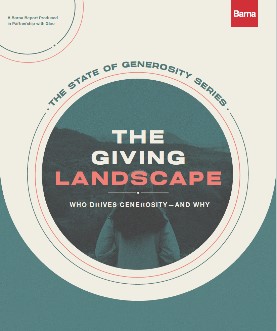“Leaders must ask themselves: How can generosity be taught?”1. That is a quote from Barna’s new study on the state of giving, entitled The Giving Landscape: Who Drives Generosity – And Why. I will review their findings in this edition of the Coach, entitled The Coach’s Review of the Latest Barna Research on the Giving Landscape. OK, that is a bland title, but you get the point. I’m going to give you the highlights of the Barna report and give you my advice on what you should do about the data.
Let me start with my opening sentence, which I quote from their study. Why would they state this? One main reason is their study discovered that 40% of U.S. adults are not givers. It might also have been because they found that just one out of four U.S. adults (25%) say generosity is extremely important to them. It could also be that they discovered, on average, U.S. adults donate about $916 a year. Yet, practicing Christians, those attending church at least once a month, give roughly triple that amount averaging about $2,000 in yearly charitable giving. So, the authors of this report assume that generosity must be taught. The question is, how? More on that later.
The report gives a snapshot of giving tendencies across various sub-groups of our society. Here are a few of their findings:
- Faith – 7 out of 10 Christians across the Church – Catholic (70%), mainline Protestant (70%), and non-mainline Protestant (68%) – are givers.
- Generation – Younger generations are stepping up but not nearly at the level of the Elder generation. Barna found that 72% of Elders are likely to be givers. Boomers come in at 64%, with Gen X at 58%, followed by Millennials at 61% and Gen Z at 51% likelihood of being givers. Their research shows that Gen Z is emerging as a justice-oriented age group.
- Race & Ethnicity – Minorities are more apt to give in America. When asked if they donated money in the last year, Hispanics led all groups, with 67% saying yes. 62% of Asians said yes to the question. 59% of white adults and black adults said yes to the question.
- Education – The likelihood of giving increases with education. When asked if they gave in the last year, 48% with a high school education or less said yes. This compares with 63% saying yes who had some college or technical training. 76% of college graduates or higher responded yes to the question.
- Income – Giving money often depends upon having money. Thus, of most full-time employees, 69% are givers versus 56% of part-timers and 54% of the unemployed. 52% of those making less than $50K a year said yes, they gave in the last year. 70% of those in the $50K to $99K range stated they gave in the last year, with 76% of those making over $100K giving in the last year.
- Family – Barna discovered that families are at the core of generosity activity. Married adults give 70% versus single adults giving at a 53% level. Adults with children under 18 give at 69% compared to adults with no children at home giving at 56%.
- Community – Givers, compared to non-givers, are more likely to live near their friends (57% versus 44% of non-givers) or their family (62% versus 52%), and they see themselves as building a community (33% versus 52%). The report concludes that a major driver for giving is spurred by the company people keep.
The report concludes with four themes they found in their study that they recommend churches focus on.
Generosity is Personal – The report states, “If generosity is commonly described as an expression of core identity, an attitude, an act of compassion or a product of prayer, then opportunities or appeals to give should also tap into people’s hearts and souls. The act of giving isn’t just an exchange or transaction, but an emotional, even sacred, thing for most people.”
Generosity is Malleable – Here, they state, “There is significant giving potential at the margins, such as the exceptionally charitable attitudes we see in nonwhite givers.” They sum up this section by saying, “An expansive, collaborative imagination for generosity considers how to partner with and nurture the generosity of people across every level of giving.” In other words, all is not lost in terms of moving people into a life of generosity.
Generosity is Intentional – The report states, “there may be practical hurdles to the frequency and amount of giving. Sometimes emotional or theological onramps may need to be built toward engagement with particular causes. But generosity and compassion, overall, are qualities or activities that can be chosen and developed.”
Generosity is Spiritual – They state, “Practicing Christians consistently outgive their peers, inside and outside the Church. (In fact, nonpracticing Christians give more like the average U.S. adult or sometimes the average non-Christian.) Practicing Christians believe God values their generosity, and they credit scripture and prayer with guiding their giving decisions. It’s possible that as people grow in their faith, they may grow in their giving, and vice versa. The two go hand-in-hand, and together fuel much of the generous activity that occurs in the U.S.”
All this information leads us back to the opening sentence, asking, how can generosity be taught? Here is my answer.
We must make stewardship education a core value of our disciple-making process. How do you do that? I advise,
Regularly preach a series on stewardship. My advice is to preach a series on stewardship every twelve to eighteen months. When was the last time you preached on giving?
Teach stewardship through small groups/Sunday school classes on a regular basis. Either in conjunction with a sermon series or as a stand-alone study done in classes in small groups, consistent teaching on stewardship will help you increase giving.
Offer some type of financial planning to help your members be financially free. One factor many people give for not giving is a lack of money. We need to help our members know how to manage what God has entrusted to them.
Use the offering time every week to teach the value and importance of giving. Today the average regular church attendee gives a little over an hour and a half a week to their church. This includes worship. So, use the one time you know you have most of your donors to educate them on the joys of giving and living a generous life.
Let me end with a comment I typically make when I review giving studies. Knowing national giving trends is helpful. It gives you insight into what possible barriers and concerns you face with donors. Yet, in my experience, a local church committed to the discipleship process can and does beat national statistics. Get started today making disciples.

Mark Brooks – The Stewardship Coach
mark@acts17generosity.com
1. https://shop.barna.com/products/the-state-of-generosity-series-the-giving-landscape


